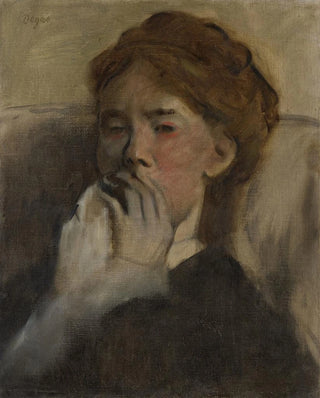Art print | Young woman with her hand on her mouth - Edgar Degas


View from behind

Frame (optional)
In the fascinating world of art, some works manage to capture the very essence of human life, revealing deep emotions through subtle gestures. "Young woman with her hand on her mouth" by Edgar Degas is one of those creations that captivates and touches. This painting, created at the end of the 19th century, perfectly illustrates Degas's skill in capturing fleeting moments, moments of reflection and mystery. The young woman, frozen in a posture that is both delicate and expressive, invites us to delve into her inner universe. Her hand placed on her mouth seems to suggest a secret or a profound thought, awakening our curiosity and imagination. This work is a true testament to the intensity of human emotions, while being rooted in the everyday life of Parisian life.
Style and uniqueness of the work
Edgar Degas's style is distinguished by his innovative approach to composition and color. In "Young woman with her hand on her mouth," the artist uses soft tones and subtle shades to create an intimate atmosphere. The play of light and shadow highlights the delicate features of the protagonist's face, while her gaze, slightly diverted, seems to capture a fleeting thought. Degas, often associated with ballet scenes and representations of modern life, here manages to transcend the simple portrait by offering a reflection on human inner life. The way he handles movement and the posture of his model demonstrates his talent for rendering complex emotions vivid, making the work both accessible and deeply moving.
The artist and his influence
Edgar Degas, an emblematic figure of the Impressionist movement, managed to establish a unique style that continues to influence generations of artists. Born in 1834 in Paris, he was initially trained in academic traditions before turning to a more modern approach. His interest in movement and the representation of the human body, notably through dance and daily life, redefined the standards of art of his time. Degas was able to capture the essence of his subjects, whether they were dancers

Matte finish

View from behind

Frame (optional)
In the fascinating world of art, some works manage to capture the very essence of human life, revealing deep emotions through subtle gestures. "Young woman with her hand on her mouth" by Edgar Degas is one of those creations that captivates and touches. This painting, created at the end of the 19th century, perfectly illustrates Degas's skill in capturing fleeting moments, moments of reflection and mystery. The young woman, frozen in a posture that is both delicate and expressive, invites us to delve into her inner universe. Her hand placed on her mouth seems to suggest a secret or a profound thought, awakening our curiosity and imagination. This work is a true testament to the intensity of human emotions, while being rooted in the everyday life of Parisian life.
Style and uniqueness of the work
Edgar Degas's style is distinguished by his innovative approach to composition and color. In "Young woman with her hand on her mouth," the artist uses soft tones and subtle shades to create an intimate atmosphere. The play of light and shadow highlights the delicate features of the protagonist's face, while her gaze, slightly diverted, seems to capture a fleeting thought. Degas, often associated with ballet scenes and representations of modern life, here manages to transcend the simple portrait by offering a reflection on human inner life. The way he handles movement and the posture of his model demonstrates his talent for rendering complex emotions vivid, making the work both accessible and deeply moving.
The artist and his influence
Edgar Degas, an emblematic figure of the Impressionist movement, managed to establish a unique style that continues to influence generations of artists. Born in 1834 in Paris, he was initially trained in academic traditions before turning to a more modern approach. His interest in movement and the representation of the human body, notably through dance and daily life, redefined the standards of art of his time. Degas was able to capture the essence of his subjects, whether they were dancers






